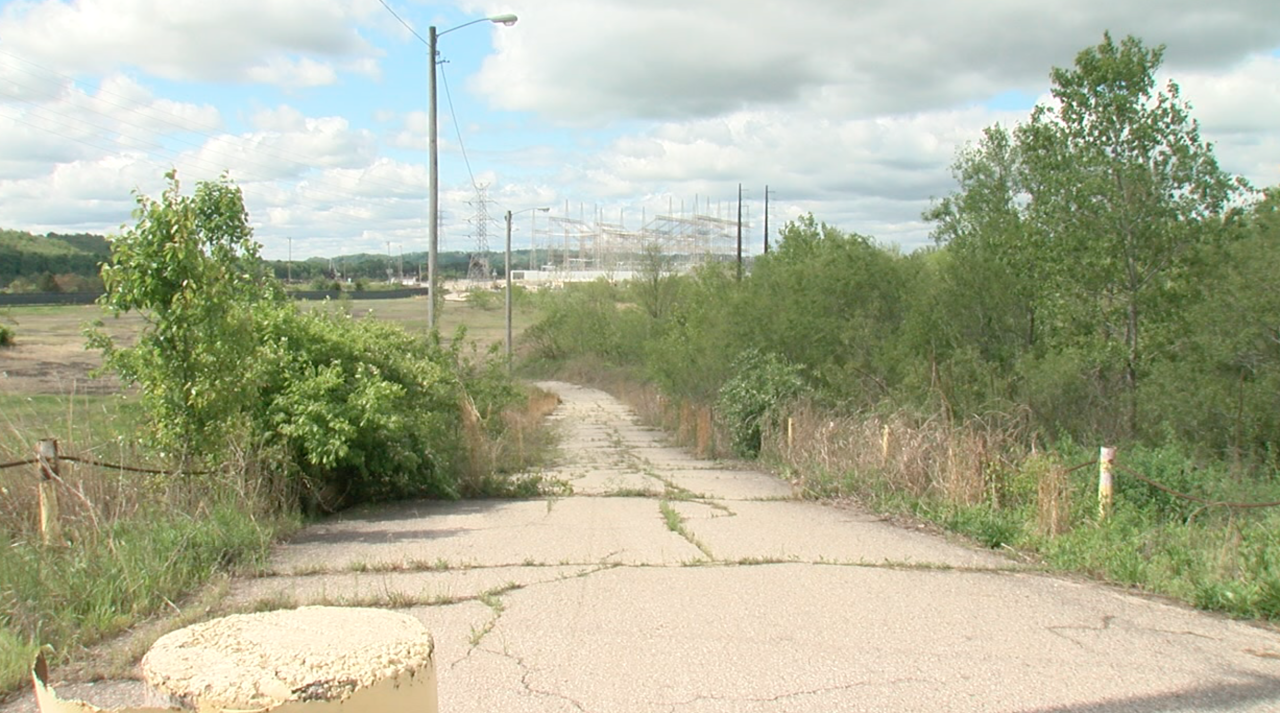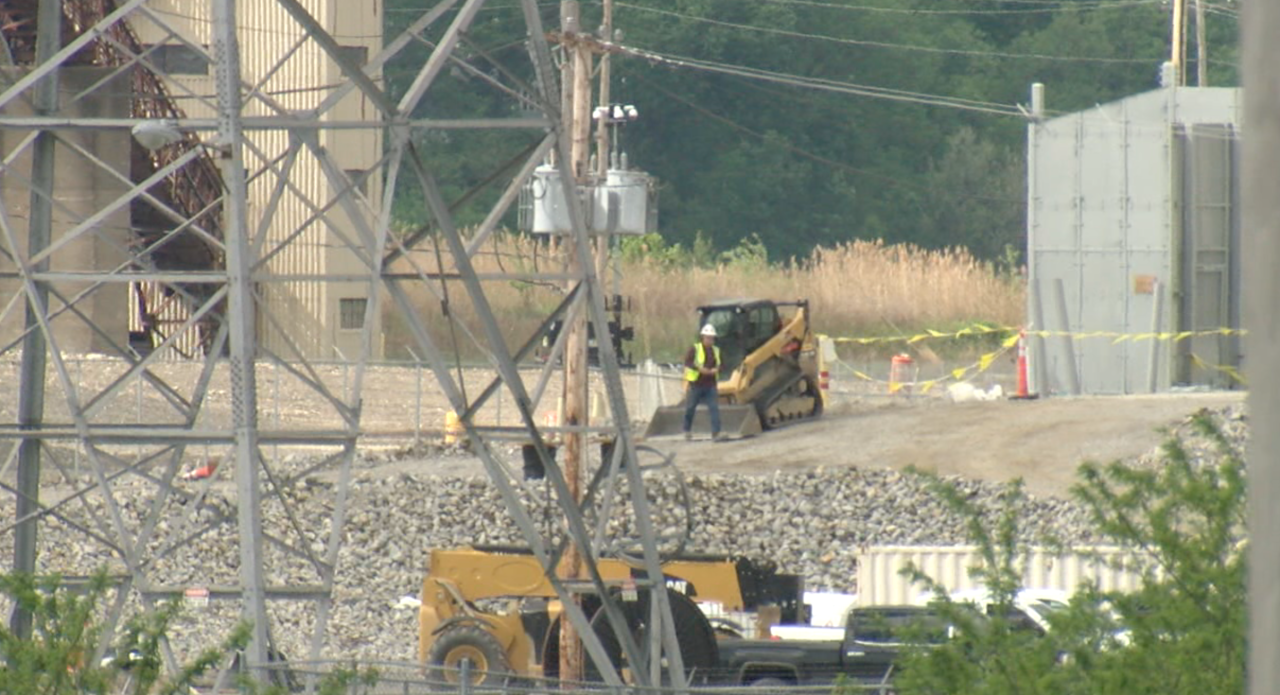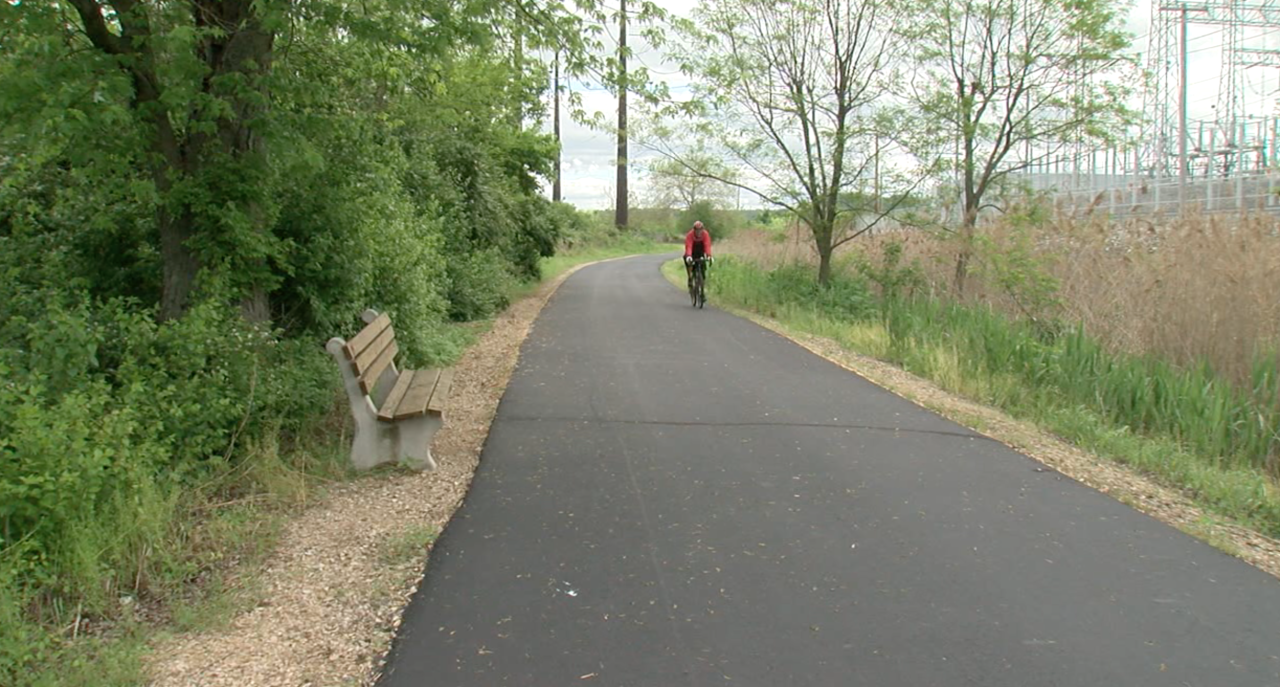LAWRENCEBURG, Ind. — The towering smokestacks at the Tanners Creek Generating Station in Lawrenceburg, Indiana, stood for decades.
On a spring day in 2018, it took a demolition crew just 15 seconds to bring the stacks to a crash-landing that could be seen and heard for miles. The event marked an important milestone in the cleanup and development of the former American Electric Power Company plant, closed in 2015.
"It was an exciting time," said Lawrenceburg Mayor Kelly Mollaun.
That's because the plan was to create Indiana's fourth port, expected to create thousands of jobs and millions of dollars in tax revenue.
"Once you put a port in, it's not going anywhere," Mollaun said. "We're talking about jobs that are generational."
But it wouldn't turn out to be that easy. The deal fell through, in part, because the property couldn't be developed due to the potentially harmful aftereffects of burning coal.
As part of our ongoing investigation, Closed and Undisclosed, the WCPO I-Team went to Lawrenceburg to learn what could befall the dozens of coal plant sites across the region and the country. Could these sites be a boon to the communities in which they sit, or will they leave more questions than solutions?

As the nation transitions away from coal, the giant plants that once supported small towns are closing and taking with them the highest-paying jobs and biggest source of tax revenue. In the Tri-State region, utility companies have shuttered five coal-fired plants in the past decade and will close two more by 2027.
How will the sites be cleaned up? Who is monitoring air quality and drinking water? Will developers move in with new jobs or will the legacy of these coal towns be tainted land and unemployment?
Once one of the most coal-heavy states, Ohio is now leading the nation in plant closures. Former coal towns are struggling in how to transition away from this declining industry.
In our first stories, the I-Team examined demolition problems at Beckjord and the Killen Generating Station in Adams County.
This story examines the business deal that wasn't meant to be at the Tanner's Creek coal plant in Lawrenceburg. It looks at how the lessons learned could be instructive for other local communities with closed power plants along the Ohio River, including the Beckjord site in Clermont County, which is being marketed as a possible location for a port.
The Lawrenceburg deal was born when, in 2017, Indiana's port authority bought an exclusive right to acquire the property and turn it into Indiana's fourth port, a major transportation hub on the Ohio River that was expected to create thousands of jobs and millions of dollars in tax revenue.
But last September the Ports of Indiana announced it had killed the agreement because the cleanup of coal ash and other byproducts of burning coal would have been too costly.
"The Ports of Indiana concluded that the remediation work would take years to complete on a significant portion of the land, rendering the site economically unviable as a port facility at this time," according to the Ports of Indiana's statement.
"It is frustrating," Mollaun said. "I would have expected more to be done up to this point."

The possibility of turning Tanners Creek into a thriving port, then seeing that dream die, was a difficult blow to Lawrenceburg and many surrounding communities.
"What's going on at the Tanners Creek site is going to be a big obstacle and a burden on the communities into the future, because of the problems that are there," said Tim Maloney, senior policy director of the Hoosier Environmental Council, an Indianapolis-based nonprofit focused on environmental advocacy.

Those obstacles were recorded in 2018 when the Ports of Indiana hired a consultant, ATC Group Services, which conducted a subsurface investigation of the Tanners Creek site.
ATC found potentially harmful coal ash as deep as 40 feet below the surface. Soil and groundwater were contaminated with heavy metals, including arsenic, their investigation found.
This area is also part of the Ohio River flood plain. And the Ohio River is what provides drinking water to millions of Greater Cincinnatians.
"It's the perfect storm of conditions that are about as undesirable as you can get," Maloney said.
Is drinking water safe?
Pam Rigacci leaned on a post for support as she overlooked the mostly barren Tanners Creek property located about one mile from her Lawrenceburg home.

"It's scary," Rigacci said. "I mean, would you want to live here?"
Rigacci told the I-Team she has complained for years about not getting enough information on the threat coal ash poses to local drinking water.
"I use bottled water for cooking and drinking," Rigacci said.
But utilities in Lawrenceburg and nearby Aurora insist tests on groundwater in municipal wells show the drinking water is safe.
"All of the water-quality data collected by the Lawrenceburg Municipal Utility has shown no indication that wells have been affected by or are threatened by the ash sites in the area," according to a March 2019 report by Intera, a geosciences and engineering firm hired to examine risks to Lawrenceburg's drinking water. The report also examined the municipal wells of nearby Aurora.
"There's nothing there to raise a red flag," said Randy Turner, Aurora's Utility Superintendent for the last 28 years. "But it bears watching."
Under a 1977 agreement, AEP is required to take samples twice a year from municipal wells used by utilities serving Aurora, Lawrenceburg, Manchester and Sparta.
Aurora's three municipal wells are within 1,000 feet of one of the coal ash ponds, Turner said.

Turner also said their agreement with AEP requires the company to locate and provide a new supply of drinking water if Aurora's wells become contaminated with heavy metals linked to the coal ash at Tanners Creek.
"Water is the most valuable asset we have. We have to protect it," Turner said. "Chances are, in my lifetime, we're not going to have a problem, but what about my grandchildren?"
The cleanup plan
The cleanup of the coal ash at the Tanners Creek site requires a complex, multi-layered approach that is still partly unresolved six years after the plant closed.
The property owner, Tanners Creek Development, submitted detailed plans to the Indiana Department of Environmental Management for permanently storing the coal ash in areas on-site.
IDEM requires a separate closure and post-closure plan for different coal ash containment areas of the property. Coal ash, a potentially hazardous byproduct of the burning of coal, sits in unlined pits, called ponds, at many coal plants around the country. Closing, or capping, them requires an extensive plan to keep the surrounding area as clean as possible.
In order to get accurate answers to detailed questions about the cleanup of Tanners Creek, the I-Team emailed questions to IDEM and gave the agency a week to answer them.
IDEM has approved the closure and post-closure plan for the Fly Ash Pond. Some parts of that plan are behind the initial schedule, according to IDEM.
The lined, permitted Restricted Waste Site landfill is in the process of being closed, according to IDEM, and may be closed within a few months.

The regulatory agency also approved a Groundwater Monitoring Plan and Site Investigation Work Plan for the Main Ash Pond. However, IDEM said it has asked Tanners Creek Development to do more investigation of that area, including an examination of the clay layer beneath the pond.
Maloney said the most concerning part of the Tanners Creek cleanup plan is IDEM's decision to allow the massive amounts of coal ash to remain there.
"The answer is to excavate the coal ash and move it to a safe lined landfill where it won't be contaminating groundwater," Maloney said.
The Hoosier Environmental Council filed a petition on May 8, 2020 with the Indiana Office of Environmental Adjudication seeking to require Tanners Creek Development and IDEM to revoke or modify the closure plan for the 71-acre Fly Ash Pond.
The petition asks the OEA to require coal ash "waste to be excavated and moved to a dry landfill away from the drinking water wells and not in a floodplain."
The petition, and the Hoosier Environmental Council's additional filings, accuse IDEM and Tanners Creek Development of failing to follow Indiana regulations requiring "management practices that are protective of human health and the environment."
Tanners Creek Development has asked OEA to dismiss the petition, saying IDEM's approval of the plan "met all the applicable legal standards."
In its written responses to the I-Team's questions, IDEM said it approved using fewer monitoring wells than it initially required in the cleanup.
"The reduced monitoring well network is intended to be temporary and to inform future expansion of the network," IDEM said.
The Hoosier Environmental Council has filed a petition for review of the groundwater monitoring plan, which asks OEA to increase the number of groundwater monitoring wells.
The OEA has not ruled on motions for summary judgment in both cases, according to Catherine Gibbs, Environmental Law Judge for the OEA.
Judge Gibbs said rulings on the motions are expected this summer.
"The site needs to be cleaned up properly and restored so it can be reused in some fashion," Maloney said.
The property owner
Commercial Development Company claims to be North America's biggest buyer and developer of "environmentally-challenged, retired" industrial real estate.
It owns more than 300 properties, including the purchase of seven power plants since 2014, according to the company's website.
The I-Team sent emails and left phone messages with three different Commercial Development Company representatives requesting an interview or a written statement about the cleanup and development of the Tanners Creek site. We also requested a tour of the property.
The company finally declined our requests after the I-Team emailed a similar request to Commercial Development Company's general counsel.
The company's website reveals basic information about its approach to conducting business.
Commercial Development Company buys the properties. Other affiliated businesses take on separate and clearly defined roles.
Environmental Liability Transfer assumes the liability connected to the properties.
EnviroAnalytics Group manages the environmental cleanup.
Industrial Demolition oversees demolition work.
Industrial Asset Recovery Group sells assets from the properties, including scrap metal.
Commercial Development Company's website reveals little about Tom and Michael Roberts, the brothers who are Principals of the company they founded in 1990.
The I-Team learned more about the Roberts brothers, their company, and how they conduct business through their own words in depositions.
Those records, filed in a 2015 lawsuit against Michael Roberts, Commercial Development Company, and Sparrows Point LLC, one of their businesses in Maryland, are not related to Tanners Creek.
But some of the information disclosed by the Roberts brothers reveals business practices that are used company-wide, according to their depositions.
Brief public excerpts of those "confidential" depositions, videotaped in December 2015 at the Grand Marriott Hotel in St. Louis, are filed in the lawsuit.
In his deposition recorded on Dec. 1, 2015, Tom Roberts testified the brothers "discuss each project."
Tom Roberts testified the brothers discuss "what we were going to do with the property, how we were going to do the cleanup."
"When new projects are brought on board, we, depending on prior workload, determine who takes that project," Tom Roberts testified in his deposition.
Based on IDEM records, Michael Roberts appears to be leading the Tanners Creek project.
IDEM sent a letter addressed to the attention of Michael Roberts on April 23, 2020, informing Tanners Creek Development that state agency had approved the company's plan for closure and post closure of two coal ash waste sites subject to terms in the letter.
"Public records for your facility are available in IDEM's Virtual File Cabinet," according to the letter addressed to Michael Roberts.
In his deposition on Dec. 2, 2015, Michael Roberts testified that Sparrows Point LLC made an estimated $85 million profit on the sale of the 3,100 acre site near Baltimore.
The depositions were part of a case in which Sparrows Point's former "local representative," John Macsherry Jr., claimed he was entitled to a sales commission. The case settled earlier this year for an undisclosed sum.
"Today, the site has a brighter future," according to the Commercial Development Company website. "The 3,100-acre former steel mill is now in the later stages of environmental remediation and is currently being transformed into a major NE logistical hub."
The development is an "epic turnaround tale," according to a 2019 article by Bloomberg.
In 2018, Commercial Development Company moved into a new corporate headquarters in St. Louis, according to the St. Louis Post Dispatch.
The 50,000-square-foot office building was built on an old rock quarry site purchased by the company in 1994.
What's next?
In a brochure, Commercial Development Company lists the Lawrenceburg property as one of its "success stories."
But what will Tanners Creek look like years from now?

The company's website has an aerial map of the property showing its 200+ acre waterfront lot and rail spur to CSX.
"Today the property represents a rare opportunity for an industrial user to take advantage of the site’s outstanding development attributes," according to a company "sales sheet" uploaded to the company's website. "This property can easily accommodate a variety of end users, including manufacturing, logistics support, port operations, data centers, and more."
Lawrenceburg Mayor Kelly Mollaun believes the site "will eventually be a very nice piece of property for development. I firmly believe that."
But just a few minutes after expressing his confidence in the future of the Tanners Creek property, the mayor pondered the risk of leaving all of that coal ash on the Lawrenceburg riverfront.
"How do you mitigate the problem completely? Maybe you take it somewhere else," he said.
"But how do you know if you ever got it all?"






